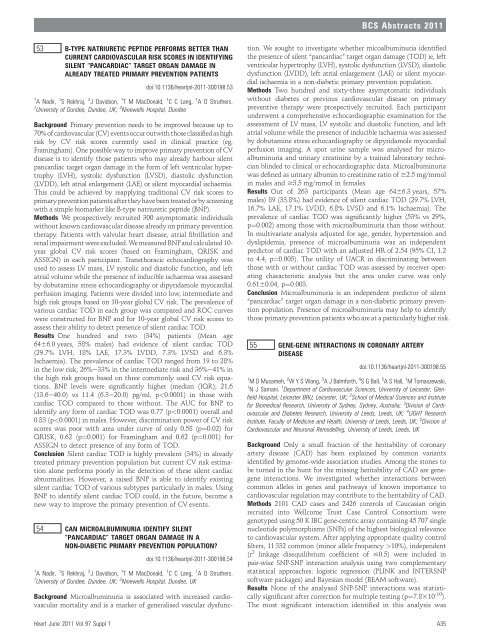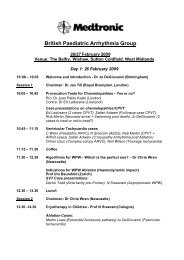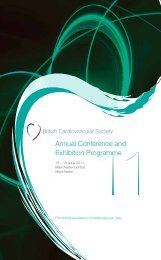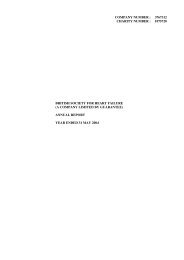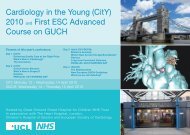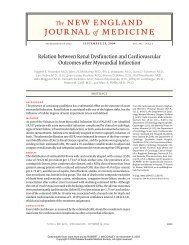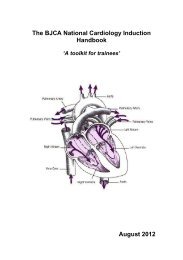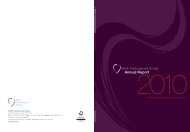Full Supplement - British Cardiovascular Society
Full Supplement - British Cardiovascular Society
Full Supplement - British Cardiovascular Society
You also want an ePaper? Increase the reach of your titles
YUMPU automatically turns print PDFs into web optimized ePapers that Google loves.
BCS Abstracts 2011<br />
53 B-TYPE NATRIURETIC PEPTIDE PERFORMS BETTER THAN<br />
CURRENT CARDIOVASCULAR RISK SCORES IN IDENTIFYING<br />
SILENT “PANCARDIAC” TARGET ORGAN DAMAGE IN<br />
ALREADY TREATED PRIMARY PREVENTION PATIENTS<br />
doi:10.1136/heartjnl-2011-300198.53<br />
1 A Nadir, 1 S Rekhraj, 2 J Davidson, 1 T M MacDonald, 1 C C Lang, 1 A D Struthers.<br />
1 University of Dundee, Dundee, UK; 2 Ninewells Hospital, Dundee<br />
Background Primary prevention needs to be improved because up to<br />
70% of cardiovascular (CV) events occur outwith those classified as high<br />
risk by CV risk scores currently used in clinical practice (eg,<br />
Framingham). One possible way to improve primary prevention of CV<br />
disease is to identify those patients who may already harbour silent<br />
pancardiac target organ damage in the form of left ventricular hypertrophy<br />
(LVH), systolic dysfunction (LVSD), diastolic dysfunction<br />
(LVDD), left atrial enlargement (LAE) or silent myocardial ischaemia.<br />
This could be achieved by reapplying traditional CV risk scores to<br />
primary prevention patients after they have been treated or by screening<br />
with a simple biomarker like B-type natriuretic peptide (BNP).<br />
Methods We prospectively recruited 300 asymptomatic individuals<br />
without known cardiovascular disease already on primary prevention<br />
therapy. Patients with valvular heart disease, atrial fibrillation and<br />
renal impairment were excluded. We measured BNPand calculated 10-<br />
year global CV risk scores (based on Framingham, QRISK and<br />
ASSIGN) in each participant. Transthoracic echocardiography was<br />
used to assess LV mass, LV systolic and diastolic function, and left<br />
atrial volume while the presence of inducible ischaemia was assessed<br />
by dobutamine stress echocardiography or dipyridamole myocardial<br />
perfusion imaging. Patients were divided into low, intermediate and<br />
high risk groups based on 10-year global CV risk. The prevalence of<br />
various cardiac TOD in each group was compared and ROC curves<br />
were constructed for BNP and for 10-year global CV risk scores to<br />
assess their ability to detect presence of silent cardiac TOD.<br />
Results One hundred and two (34%) patients (Mean age<br />
6466.0 years, 58% males) had evidence of silent cardiac TOD<br />
(29.7% LVH, 18% LAE, 17.3% LVDD, 7.3% LVSD and 6.3%<br />
Ischaemia). The prevalence of cardiac TOD ranged from 19 to 28%<br />
in the low risk, 26%e33% in the intermediate risk and 36%e41% in<br />
the high risk groups based on three commonly used CV risk equations.<br />
BNP levels were significantly higher (median (IQR); 21.6<br />
(13.6e40.0) vs 11.4 (6.3e20.0) pg/ml, p


